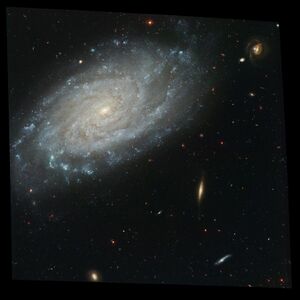Astronomy:NGC 3370
| NGC 3370 | |
|---|---|
 | |
| Observation data (J2000 epoch) | |
| Constellation | Leo |
| Right ascension | 10h 47m 04.0s[1] |
| Declination | +17° 16′ 25″[1] |
| Helio radial velocity | 1279 ± 4 km/s[1] |
| Distance (comoving) | 82.19 ± 5.871 Mly (25.2 ± 1.8 Mpc)h−10.6774 |
| Distance | 78 Mly (23.91 Mpc)h−10.6774 (Light-travel) |
| Group or cluster | NGC 3370 Group |
| Apparent magnitude (V) | 12.3[1] |
| Characteristics | |
| Type | SA(s)c[1] III[citation needed] |
| Size | 49,930 to 77,270 ly (15.31 to 23.69 kpc) (diameter; 2MASS K-band total and D25.0 B-band isophotes)[1] |
| Apparent size (V) | 3.2′ × 1.8′[1] |
| Notable features | Dusty |
| Other designations | |
| Silverado Galaxy[citation needed], UGC 5887, PGC 32207 | |
NGC 3370 (also known as UGC 5887 or Silverado Galaxy[2]) is a spiral galaxy about 82.2 ± 5.9 million light-years (25.2 ± 1.8 megaparsecs) away in the constellation Leo. It is nearly comparable to our Milky Way both in diameter with a D25 isophotal size about 77,300 ly (23.69 kpc) comparing to the Milky Way Galaxy's 87,400 ly (26.8 kpc) diameter, and as well as in mass (1011 M☉).[citation needed] NGC 3370 exhibits an intricate spiral arm structure surrounding a poorly defined nucleus. It is a member of the NGC 3370 Group of galaxies, which is a member of the Leo II Groups, a series of galaxies and galaxy clusters strung out from the right edge of the Virgo Supercluster.[3]
History
NGC 3370 was likely discovered by William Herschel, who provided it with the designation II 81.[4] His son John later designated it 750. William Herschel cataloged I 80 to NGC 3348[4] before and II 82 to NGC 3455 after NGC 3370.[4]
The object has a surface brightness of 13 and a position angle (PA) of 140°.
On November 14, 1994, S. Van Dyk and the Leuschner Observatory Supernova Search discovered a supernova in NGC 3370 at 10h 44m 21.52s +17° 32′ 20.7″, designated SN 1994ae.[5] SN 1994ae was a type Ia supernova, and one of the nearest and best observed since the advent of modern digital detectors.[6] The maximal light of the supernova was estimated to have occurred between November 30 and December 1[citation needed], peaking at visual magnitude 13.[5]
See also
- NGC 1365, spiral galaxy
References
- ↑ 1.0 1.1 1.2 1.3 1.4 1.5 1.6 "NASA/IPAC Extragalactic Database". Results for NGC 3370. http://nedwww.ipac.caltech.edu/.
- ↑ Sparrow, Giles (2006). Cosmos. Booksales. ISBN 978-1-905204-29-8.
- ↑ "The Leo III Groups". Atlas of the Universe. http://www.atlasoftheuniverse.com/galgrps/leoii.html.
- ↑ 4.0 4.1 4.2 William Herschel's Deepsky Objects (The Herschel 2500 list)
- ↑ 5.0 5.1 A Look at NGC 3370 in Detail
- ↑ "Celestial Composition". ESA/Hubble. http://www.spacetelescope.org/images/opo0324a/.
External links
- HST: Celestial Composition
- Ho et al., BVRI Photometry of Supernovae
- NGC 3370 at ESA/Hubble
- NASA Astronomy Picture of the Day: Spiral Galaxy NGC 3370 from Hubble (12 October 2008)
 |


